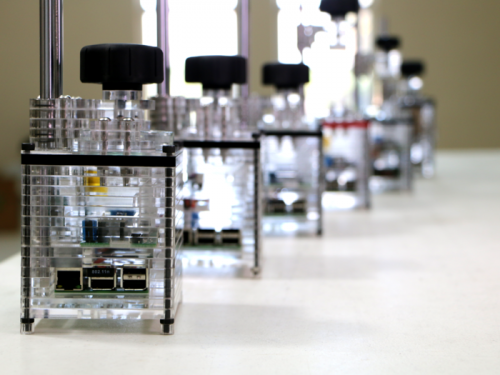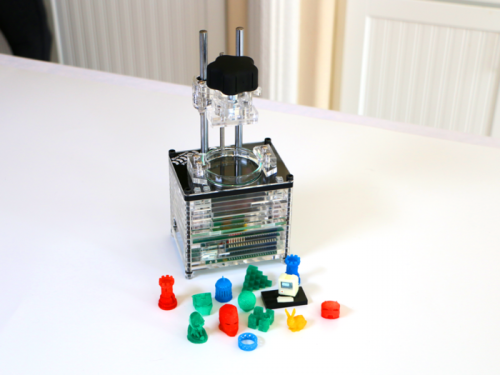iBox Printers is issuing a claim that it has the world's smallest, most affordable 3D printer. "Most 3D printers are expensive, large, noisy and complicated," said Trent Carter, founder of the Melbourne, Florida-based company. They have introduced their iBox Nano on Kickstarter. The creators had four goals for the iBox Nano—to be small, quiet, inexpensive and portable. The product is a 3D resin printer and it is constructed of precision laser cut extruded acrylic. Why resin? The team said resin has outstanding properties and advantages over FDM, which stands for Filament Deposition Modeling. Many of the resin printers on the market use DLP technology to create and control the UV light used to cure the resin.
"DLP projector bulbs will need to be replaced at their service interval, generally at 2000-8000 hours of use. Even before they fail they will suffer a noticeable loss in output power," whereas the iBox Nano uses UV LEDs rated at 50,000+ hours, which is equivalent to 17 years, running eight hours a day. Andrew Liszewski expanded on their use of resin in Gizmodo. He said, "Instead of the plastic microfilament that most consumer-level 3D printers melt and extrude to slowly build up a model, the iBox Nano uses a small pool of liquid resin that's hardened, layer by layer, using ultra-violet LEDs. So the printer doesn't need noisy cooling fans, doesn't produce that awful melted plastic smell, and can actually run on battery power when needed."
How quiet is the printer? That is another stated advantage. "Our printer uses very little power and generates almost no heat, thus not requiring a cooling fan and its associated noise." 3D Printers of all technologies have cooling fans and stepper motors. Both generate noise pollution. FDM printers, they said, use four stepper motors and generate a tremendous amount of random and distracting sounds. Projector and laser 3D printers have one to two stepper motors and have high volume cooling fans which are inherently noisy.
Their three-pound printer is designed for the home user who wants to print small to average-sized 3D objects with good resolution. The printer prints at 328 microns on the X-Y axis and can print down to 0.39 microns on the Z axis. (The higher the Z resolution the less banding in the Z axis and the smoother the layers look. Printing in extreme Z precision will increase print times proportionately, but the option is there, they said.) They said engineering-quality prints are possible. They boast about its precision with the prints matching original dimensions so well that only calipers can tell. Above all, they highlight the lack of complexity and convenience of their printer. "Almost all 3D printers have several wires; a USB cable to connect to your computer and a power cable. The iBox Nano is WiFi- enabled so you will never be tethered to your computer," said the team. With the iBox Nano, you can print from any browser; from your iPhone, your iPad, any Android device, Windows PC or Mac." If you choose, you can print over Ethernet using the integrated 100BaseT interface.
You can print without installing any software. As there is no software to install, "you can spend less time setting up prints and more time printing," they said. A 10-hour battery for on-the-go printing is available as an optional purchase.
For a pledge listed at $269, the iBox Nano comes along with one 95ml container of resin in red, green, blue, or yellow with an estimated delivery date of April.
More information: www.kickstarter.com/projects/8 … t-expensive-3d-print
© 2014 Tech Xplore
























